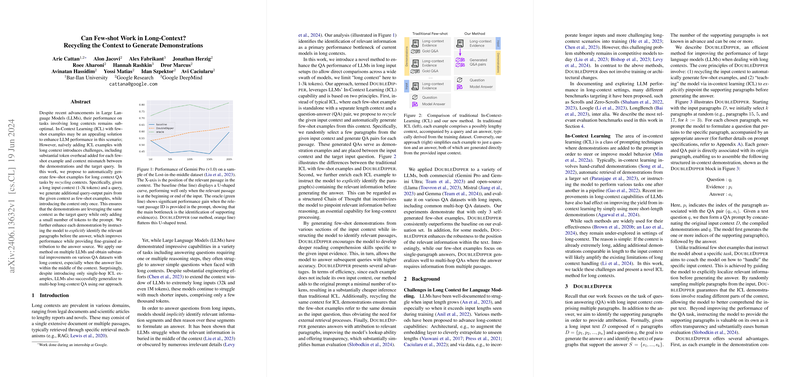Can Few-shot Work in Long-Context? Recycling the Context to Generate Demonstrations: An Expert Overview
The paper, titled "Can Few-shot Work in Long-Context? Recycling the Context to Generate Demonstrations" by Arie Cattan et al., investigates how few-shot learning can be employed to enhance the performance of LLMs on tasks involving long input contexts. The researchers propose a novel method called DoubleDipper, which aims to optimize Question Answering (QA) tasks by generating few-shot examples directly from the provided long input context.
Problem Statement and Motivation
Despite significant advancements, LLMs struggle with tasks requiring understanding and processing extensive input contexts. Addressing this challenge is critical for applications in domains like legal document analysis, scientific literature review, and detailed report generation. Traditional In-Context Learning (ICL) methods, which introduce examples into the prompt, often exacerbate the problem by adding token overhead and context mismatch issues.
Proposed Solution: DoubleDipper
The DoubleDipper method hinges on two main principles:
- Recycling Input Context for Few-shot Examples: Instead of adding separate, lengthy contexts for each example, the method generates question-answer (QA) pairs from the existing input context. This eliminates the token overhead and ensures that examples are always relevant to the input domain.
- Explicit Identification of Relevant Information: The model is instructed to identify the relevant paragraphs before generating the answer, promoting a structured approach akin to Chain-of-Thought reasoning.
Methodology
The process involves the following steps:
- Selecting random paragraphs from the input context of 1-3k tokens.
- Generating QA pairs from these paragraphs.
- Incorporating these pairs into the prompt as demonstrations.
An example provided in the paper demonstrates this approach, showing how paragraphs are selected and transformed into QA pairs used within the context to answer the query. The method effectively reduces token overhead and aligns the demonstrations with the input context, improving model performance and efficiency.
Experimental Setup and Results
The paper evaluates DoubleDipper across a variety of LLMs, including Gemini Pro, Gemini Ultra, Llama-2 variants, Mistral, and Gemma, using datasets like Lost-in-the-middle, FLenQA, HotpotQA, 2Wiki, and MuSiQue. The results indicate substantial improvements over the baseline models:
- Performance Gains: DoubleDipper (Self) saw an average improvement of 12%, while DoubleDipper (PaLM 2) achieved a 23% boost across various QA datasets.
- Improved Robustness: The method flattened the performance U-curve, showing robustness against the position of relevant information within long contexts, notably enhancing performance even when critical information was buried in the middle of the input.
Analysis and Evaluation Criteria
The analysis underscores the effectiveness of few-shot examples generated from the input context. Notably, the paper explored different k values (number of examples) and found that three examples are typically sufficient for significant performance enhancements, aligning with prior research indicating diminishing returns beyond 3-5 few-shot examples.
Implications and Future Developments
Theoretical Implications: The findings suggest that in-context learning can be optimized by focusing on recycling and appropriately structuring the demonstrations rather than extending context windows. This potentially shifts future research towards more efficient context management strategies within LLMs.
Practical Implications: Practically, the results can improve the deployment of LLMs in real-world applications where context windows are constrained, such as legal document processing or multi-step information retrieval in domains like healthcare.
Future Research Directions:
- Specialized Models for Few-shot Generation: To mitigate longer inference times, smaller, specialized models for generating few-shot examples could be developed.
- Language and Token Range Diversity: Future evaluations should encompass a broader range of languages and token ranges to generalize findings.
- Strategic Paragraph Selection: Optimizing paragraph selection strategies within the DoubleDipper framework could further enhance model efficacy.
Conclusion
The paper by Cattan et al. puts forth DoubleDipper, a method that efficiently leverages few-shot learning within long contexts, addressing key challenges LLMs face in handling extensive inputs. The empirical results solidify its efficacy, offering substantial improvements over traditional baselines and presenting a significant step forward in the field of long-context processing for LLMs. This method not only boosts performance but also offers operational efficiency and transparency in model outputs, which are crucial for both academic and practical advancements in AI.
